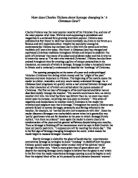How Does Dickens Portray Scrooge in the Beginning of “A Christmas Carol”?
In this essay I am going to describe how Scrooge has been portrayed by Dickens in Stave One of “A Christmas Carol”. I will be exploring Dickens’ use of language to create Scrooge’s miserable and mean character and the effects of this. I will also explore how the reader sees Scrooge from the point of view of other characters in the first stave and how Dickens’ treatment of Scrooge shows us aspects of other characters in this novel.
Charles Dickens was born in Portsmouth in 1812 and died in 1870 before finishing his final novel. He had a large family and many friends. The novels he wrote were Oliver Twist (1837-1839), Nicholas Nickleby (1838-1839), A Christmas Carol (1843), The Chimes (1844), Bleak House (1852) and Hard Times (1854), as well as various other books. Many of his novels were first sold as serialisations, which means that there are cliff-hangers at the end of each chapter so readers would look forward to and buy the next instalment. A lot of his work was not only entertainment but aimed to give a voice to the poor and act as a critic of Victorian society. When Charles Dickens was twelve his father was imprisoned for debt. His later work was inspired by this humiliating experience and he felt a moral obligation to tell readers about the actual conditions of the poor and make them feel how bad it was. He was instrumental in making changes to the Poor Law.
In the nineteenth century a lot of people were living in poverty. Many people lived in the countryside in Dickens’ time. The Industrial Revolution which had been under way for sixty years led to rapid growth in cities. The urbanisation was so rapid that the quality of housing and conditions for the poor were appalling. People worked long hours in dangerous factories and went home to squalor. The wealthy people lived in luxury. There was a great divide between the rich and poor and it was difficult to move up the social scale. The recent history of the French Revolution (1789) had made the British government fear revolution, so there was a harsh regime for the unruly – they were imprisoned without trial and were even sentenced to public executions. The 1834 Poor Law did institute workhouses to take care of the poor, though the intention was to make them so bad that the poor would not want to be sent to them, which saved parishes money.
Dickens’ moral message in “A Christmas Carol” is that if you treat others kindly, you yourself will be treated kindly and be happy. This is shown through the theme where richness of spirit is shown as overcoming the suffering of the very poor. The character Bob Cratchit symbolises this. He is shown as being poor, and therefore not valuable to people of wealth, but he is valued as a person within his own family. He is forced into poor working conditions with long hours, cold and no time with his family, working in a “dismal little cell” – the word “cell” giving the impression of a prison to the reader. Dickens is pointing this out as a social injustice. The theme contrasts between rich and poor, usually showing off the rich as being cold-hearted and selfish and the poor as being good and kind. There are many examples of Scrooge’s meanness, saying “I can’t afford to make idle people merry”, “what reason have you to be merry? You’re poor enough”, saying “it’s not convenient … and it’s not fair” to Bob Cratchit, an employee who wants Christmas day off to spend with his family, and hardest of all, that if poor people would rather die than go to the workhouse, “they had better do it, and decrease the surplus population”. Scrooge’s nephew says to Scrooge “What right have you to be dismal? what reason have you to be morose? You’re rich enough”. The main themes of the novel are the contrast and relationship between affluence and poverty in the context of Victorian society, using the setting of Christmas time to demonstrate the social injustices of the time, the great divide between rich and poor and the way they treated one another. It is all overshadowed by the effects the Industrial Revolution and Poor Law had on society, especially on the poor, leaving millions unemployed, and those with jobs constantly under threat of losing them which meant employers could treat their workers as badly as they wanted. Traditionally, Christmas is “a kind, forgiving, charitable time” but Scrooge acts as a caricature of the uncaring rich employer, telling the charitable collector that he will give nothing to the charity. He asks “Are there no prisons?” for the poor to spend Christmas in – showing how cold-hearted and uncaring he is towards the poor, seeing them as criminals who do not deserve to be treated as human beings. He wants nothing to do with the festive season because it is a time of giving, loving and caring for others.







